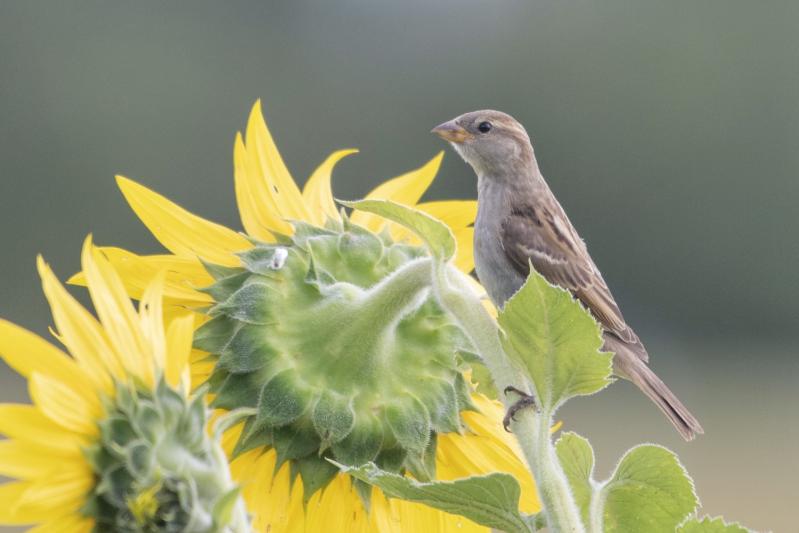House sparrows are bullies. They fight over dirt baths. They are nonmigratory, colonize habitat, and then profusely breed. When native migratory birds return to nest in the spring, these pugnacious birds force them away.
On the East End, we hear a lot about invasive species in the plant world, but the house sparrow was one of the original invasive species. Introduced to the United States in the late 19th century, they have since taken over big cities, small cities, and unloved corners of suburbia.
“The filthy habits of these birds are most annoying,” T. Gilbert Pearson wrote in “Birds of America,” published in 1917. “They gather in immense flocks to roost, and generally select cornices, ornamental work about the eaves and gables of houses, window cappings, and the vines which cover the walls of buildings. These they defile with their excrement.” Charming.
If pigeons are “rats with wings” (apparently in the 1960s they were thought to cause meningitis and were thus, wrongly, maligned), then perhaps house sparrows are the mice. Ugly mice, not the cute ones with those huge pink ears. They’re murderous, known to decapitate brooding bluebirds and tree swallows. Their song is a monotonous tweet. Hearing it reminds me of boring green giant hedges lining a square of blown sod.
Gas station landscaping for a gas station bird.
Whew.
Now for the twist. I recently had three experiences that made me sort of fall in love with this bird. At the very least, I had a crush, a short tryst.
The context is unexpected and involves middle age, Montreal, and bedbugs.
I was in Montreal to move my daughter into college. We moved her into an apartment on Sunday. The bedbugs, apparently, had moved in earlier. I stayed in the city for a week to caulk, vacuum, beer-bribe the building superintendent, and harangue the building management company into resolving the situation. In that week, while she was in class, I roamed around, worked from the college’s library, and, when free, thought of the passage of time.
Experience one: I’m walking back from my morning coffee spot. I’ve made no inroads with the French-speaking barista. I pause to look north on McTavish Street, newly graffitied by pro-Palestinian protesters. Each morning, men with power washers blast the stones clean before 95 percent of the world wakes. A single house sparrow lands on a close bench and looks up at me. It transmits a silent message of safety and is joined by two companions, then two more. In a blink, there are 30, edging toward me, warily watching. I inhale deeply. They disperse. I wake from the strange spell I didn’t realize I was under and smell pulverized chalk.
Experience two: I’m walking with my daughter from the library back to her apartment. The vibe is thick. Classes have begun. I’m not supposed to be here; the bedbugs aren’t supposed to be here. In Montreal, they don’t share our insane desire to see every bare square or rectangle filled with mowed grass. Many of their medians are planted with flowers. We pass a “street tree” surrounded only by a 3-by-3-foot square of earth. It’s full of deadheaded flowers and long grass gone to seed. Two dozen sparrows, heretofore invisible, burst out. They dissolve into the gray, brown cityscape. Startled, we laugh. We needed it.
Experience three: I’m staring out the window of her apartment just wondering, you know, about everything. I’m 50 and, surrounded by college energy, know it. This age gives me a constant feeling of unease, like I’ve just pulled out of my driveway but then think I must have left the oven on. I go back into the house. For what? Oh, the oven. Yes, it’s off.
But back at my daughter’s apartment, there’s a balcony with the same black steel railing that I recall from a fire escape outside a Brooklyn apartment I once rented when I was barely older than she is now. Potato chip-size scabs of paint peel off it to reveal bumpy red rust. From next door, the smell of some unrecognizable cuisine, cooking. Leaving her here? Alone? Three house sparrows land on the railing, a foot away, breaking up my anxious thoughts. Do they see me through the window? I watch them forever until they fly off.
Back home on the East End, the fields are turning yellow and fall sparrow season is here. I walk with a friend through her farm. We count mostly Savannah and song sparrows. Chipping sparrows are leaving, and white-throated sparrows have begun arriving for the winter. American tree sparrows should soon arrive. In the next month, here and there, clay-colored sparrows and vesper sparrows will be reported. If we’re lucky, someone will find a lark sparrow.
House sparrows, though, are always in season. A huge group relies on the median at Long Wharf in Sag Harbor. They’ll sit with you on the bench in front of Sag Harbor Books. I’ve always ignored them, or worse, judged them.
Anyway, I see them differently now.

